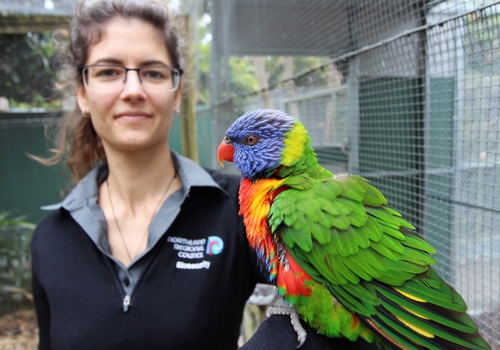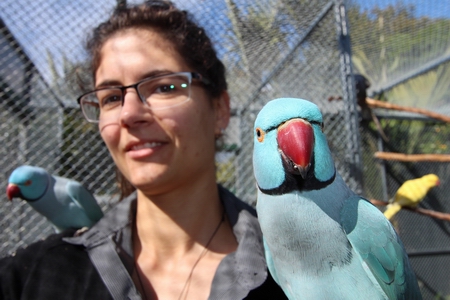Escaped exotic birds threaten North’s native species
29 Oct 2018
A recent spate of exotic bird escapes has prompted the Northland Regional Council to ask people to report any sightings of Indian ring-necked parakeets, rainbow lorikeets or sulphur-crested cockatoos in the wild.
 Regional council Biosecurity Officer Ashlee Lawrence with a rainbow lorikeet. This one is securely contained at Kerikeri’s Parrot Place bird park, but escapes by pet birds like this are fast becoming a problem in Northland.Council Biosecurity Manager Don McKenzie says the exotic aviary species threaten native bird populations by competing for food, taking nesting places and introducing diseases.
Regional council Biosecurity Officer Ashlee Lawrence with a rainbow lorikeet. This one is securely contained at Kerikeri’s Parrot Place bird park, but escapes by pet birds like this are fast becoming a problem in Northland.Council Biosecurity Manager Don McKenzie says the exotic aviary species threaten native bird populations by competing for food, taking nesting places and introducing diseases.
“Lorikeets and parakeets can also become significant agricultural pests of some cereal and fruit crops.”
Mr McKenzie says escaped pet birds are fast becoming a problem in Northland, with a number of Indian ring-necked parakeets in particular being reported missing by their owners recently.
The regional council is aware of at least eight birds loose in Northland after escaping from captivity recently; the escapes unfortunately coinciding with this year’s breeding season.
“These birds are good breeders and can establish populations quite quickly so it’s important to act fast before they breed and spread to other areas,” Mr McKenzie says.
“We need people to tell us if they have accidentally set their birds free or have seen them at large and urge them to do so as soon as possible and we’ll do our best to retrieve them or locate their owners,” he says.
All three bird species are listed as ‘Unwanted Organisms’ by the Ministry for Primary Industries and are also considered ‘Exclusion Animals’ under the Northland Regional Pest and Marine Pathways Management Plan 2017-2027.
Mr McKenzie says an exemption means it’s legal to keep, sell and breed the three species, but it’s illegal to release them into the wild and anyone doing so risks prosecution under the Biosecurity Act 1993.
 Regional council Biosecurity Officer Ashlee Lawrence with some Indian ring-necked parakeets. These birds are all securely contained at Kerikeri’s Parrot Place bird park, but escapes by pet birds like these are becoming an issue for biosecurity officials in the North.
Regional council Biosecurity Officer Ashlee Lawrence with some Indian ring-necked parakeets. These birds are all securely contained at Kerikeri’s Parrot Place bird park, but escapes by pet birds like these are becoming an issue for biosecurity officials in the North.
Indian ring-necked parakeets are natives of Africa and India. The “talkative” parrots are about 40 centimetres from their head to the tip of the tail and can be green, yellow, grey or blue.
“Most males have a distinctive thin black line around their necks. Females and young birds don’t have this marking.”
Rainbow lorikeets originate in Australia, are up to 30cm long with a distinctive blue head and belly and red/orange breast and look similar to rosellas.
Sulphur-crested cockatoos are another introduced Australian bird – the country’s most well-known parrot – with the large white birds featuring distinctive yellow crest feathers.
Mr McKenzie says all three species are commonly held in captivity in New Zealand and most wild populations establish when these caged birds escape.
“Clipping their wings is recommended as a precaution and pet owners who no longer want the birds should contact a local bird club or pet store to rehome them.”
He says anyone who does lose a ring-necked parakeet, rainbow lorikeet or sulphur-crested cockatoo, or who sees one of these exotic birds at large, should phone the regional council on (0800) 002 004.
